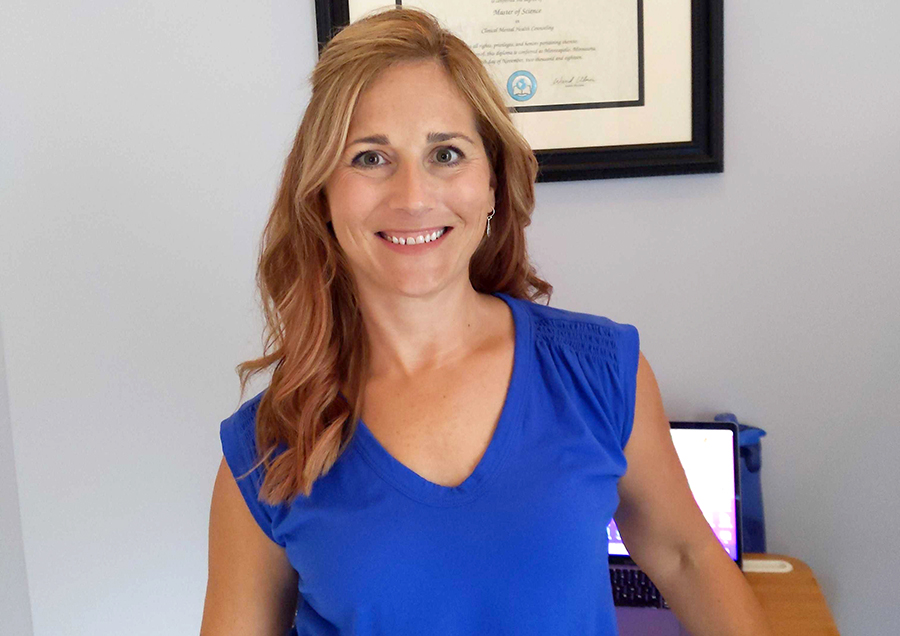
By Christine Graf
Heather Lofink, a local Licensed Mental Health Counselor, is on a mission to help athletes reach their maximum potential.
A Saratoga Springs native, Lofink worked at St. Peter’s Addiction Recovery Center before opening her own private practice in the One Roof health care building at 58 Henry St. in Saratoga Springs in February 2021.
“I put my calendar out three weeks before I opened, and I was full before I officially opened my door,” said Lofink. “I’ve been full since the day I opened, and I probably turn away three to five people a week who are reaching out for help. That’s really hard.”
Lofink is trained in eye movement desensitization and reprocessing (EMDR), a psychotherapy treatment endorsed by the American Psychological Association and Word Health Organization. EMDR is designed to alleviate the distress associated with traumatic memories.
After receiving her initial training in EMDR, she completed a sports performance EMDR course. At the time, her teenaged son was in the midst of a baseball batting slump, she said. Despite attending clinics and working with batting coaches, he was still struggling at the plate. It wasn’t until Lofink started to work with him, applying what she had learned in her trainings, that things finally improved.
“He ended up really flourishing this year,” she said. “He was on the freshman baseball team at Ballston Spa and had the highest batting average on the team. He’s also rocking it on his travel baseball team right now. It was such a big turnaround for him.”
Not long after helping her son, Lofink decided to incorporate athlete training into her practice and opened MindBody Fusion this April. When working with an athletes she starts by eliminating physical causes, such as injuries or medical conditions.
“Once we can rule out the physical side of things, any slumps or anything that is going on is a direct relation to emotional pain. The mind works in very mysterious ways,” she said. “We really dive into what is happening emotionally for them that is causing this block for them. It may be nothing related to sports.”
As an example, Lofink mentioned a baseball player who was excelling in practice but couldn’t deliver during games.
“He was a rock star batter, but he just couldn’t hit. His parents had tried every clinic and everything else that they could do,” she said.
While working with him, Lofink learned that his grandfather had recently passed away. His grandfather had been an important part of his life, and the two had a special ritual they would perform before each one of his games.
“The absence of that ritual really affected him in a way that he wasn’t able to articulate or understand,” said Lofink. “So, we processed the trauma of losing his grandfather and not having him at the games anymore. Everything really corrected at that point.”
When working with all clients—athletes and non-athletes—Lofink utilizes heart rate variability training, a form of biofeedback that teaches people to consciously control variations in their heart rate.
“I teach them about their autonomic nervous system and how to harness it,” she said. “If something feels stressful—if you are on the free throw line and the game is one the line—your heart rate goes up and your respiration goes up. You are going to start sweating and having all sorts of stress responses, and that is not helpful to your body. With heart rate variability training, we use biofeedback/neurofeedback, and I teach them how to lower their respiration and how to lower their heart rate in times of stress.”
Depending on the needs of the individual athlete, Lofink may also use bilateral stimulation which targets the amygdala, the part of the brain responsible for the flight, fight, or freeze response.
“I use Bi-Tapps, which are basically little buzzers that you hold in your hands,” she said. “What we are doing is engaging both hemispheres of the brain to distract the amygdala so that we aren’t having that stress response anymore.”
Although Lofink received a certificate in sports psychology while earning her master’s degree in clinical mental health counseling, the work that she is doing differs from sports psychology which is typically more long-term. On average, she works with an athlete for just 10 to 15 hours.
“It’s meant to be short-term. It’s different than sports psychology, which is about the pressures of sports and how to live with that. People come to me when they are really in trouble—when everything else has failed.”
Although EMDR is widely utilized by professional athletes, it is still relatively unknown.
“There’s not a lot of awareness around this, but it’s really growing,” she said. “People are starting to understand that the mental and psychological part are just as important if not more important than the physical.”
Lofink’s clinical practice is full, but she is accepting new clients for athlete training. She also offers training for teams and coaches. For more information, visit www.mindbody-fusion.com.
